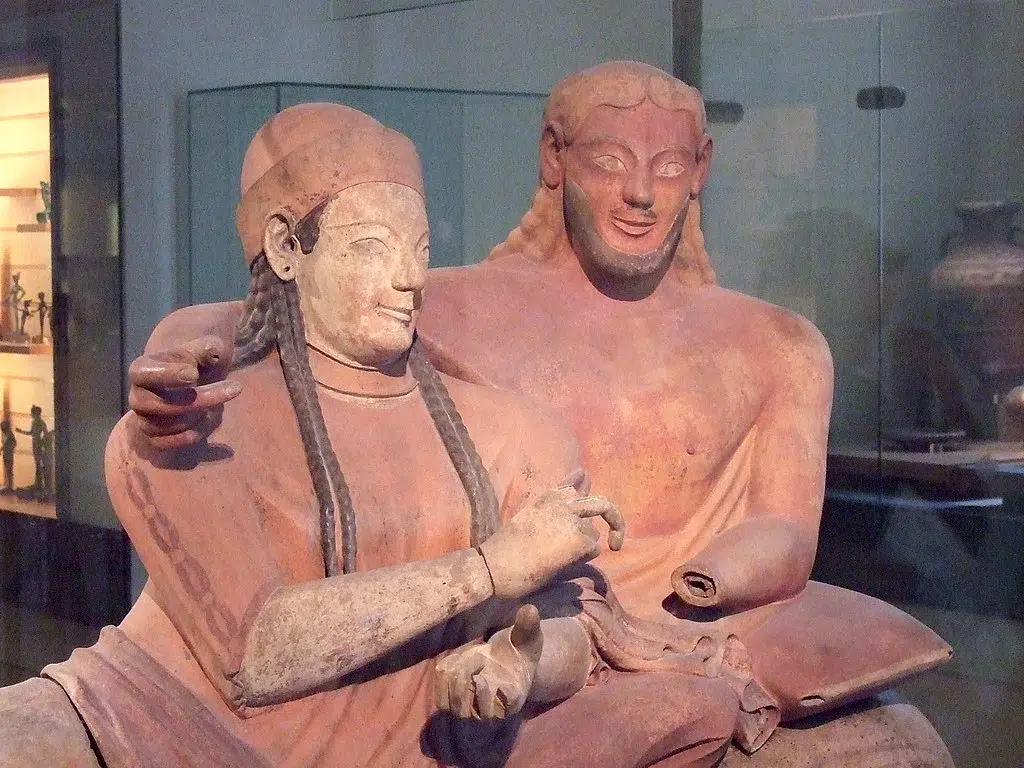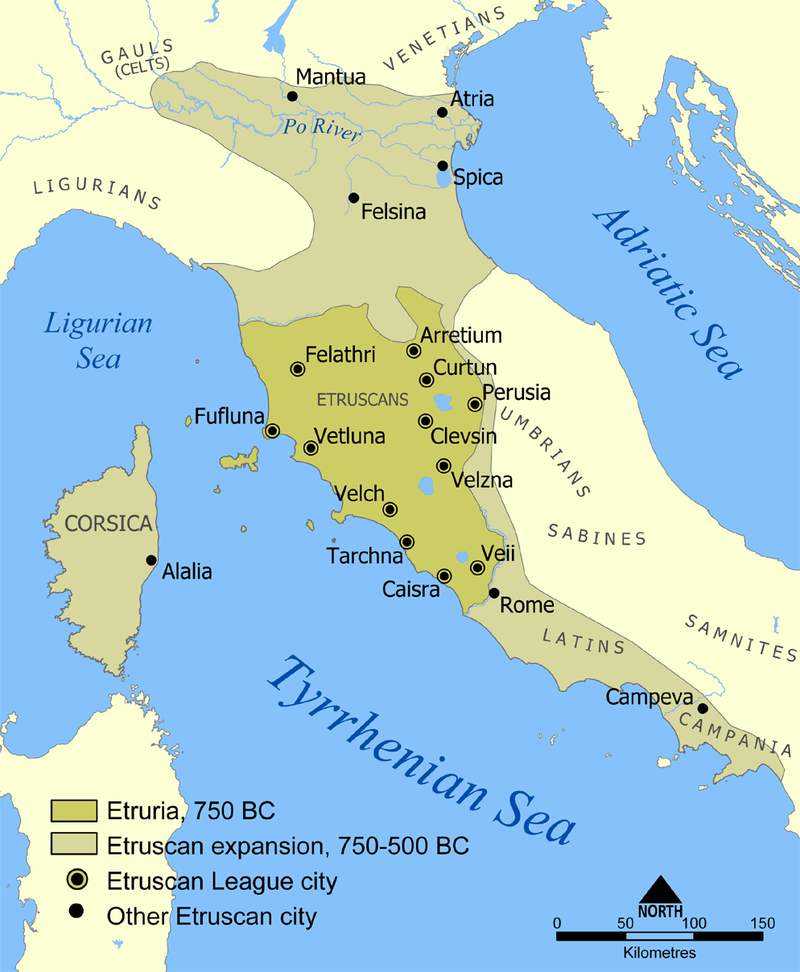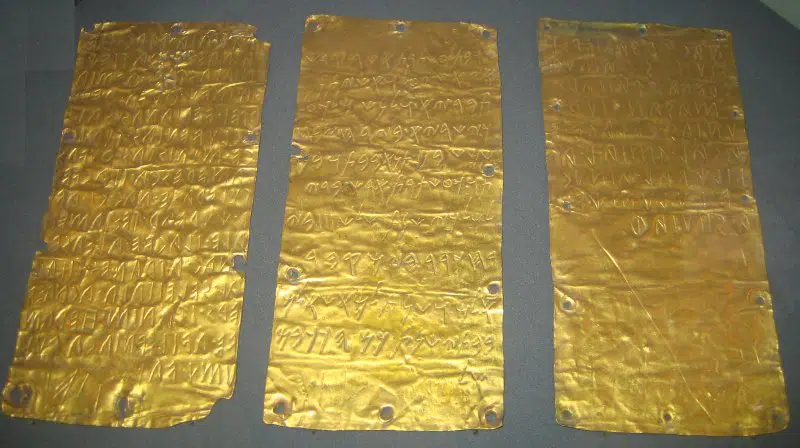
The mystery of the origins of the Etruscan people—the center of an enigma that stretches back millennia—has recently been solved, due to the miracles of DNA testing. But in effect, the answer the scientists uncovered only prompts more questions about the advanced civilization that flourished north of Rome.
It has long been known that the Etruscans, who called themselves the Rasenna and who battled the early Romans in defending their territory, had a very advanced culture with elaborate architecture and burials and grave objects of exquisite artistry showing the advancement of their technology.
The physical reminders of the Etruscans, including stunning sculpture and monuments, show that they had a rich culture valuing great craftsmanship and the production of artwork. Almost all of Etruscan art shows that they had a deep understanding and knowledge of Greek culture, as well. Their sophisticated political systems were also notable.
Until recently, however, huge holes in Etruscan scholarship remained while academics attempted to tease out more about how these people came to be and where they might have originated from.
Their language, as recorded in inscriptions from southern Etruria, dating back to approximately 700 BC, is not believed to be an Indo-European tongue. As anyone might infer, usually language is an enormous—often the determining—factor in pinning down the origins and movement of peoples.
Although they developed and used a system of writing which employs symbols borrowed from Euboean Greek script, which originated on the Greek island of Evia, the Etruscan language still remains only partly understood.
Even ancient historians such as the Greek historian Herodotus, known as the Father of History, stated that the Etruscans had migrated into Italy from Anatolia or the Aegean and that their culture was of Greek origins.
This interpretation, however, is not favored by modern scholars; archeologists have uncovered very little evidence in support of their migration from what is now Greece. The very unusual language of this people, whose culture was tantalizingly advanced for its time, has led many to assume that their origin was far from what is now Italy.
Much like the Basques, whose language is also not Indo-European, the origins of the Etruscans was assumed to be quite unlike those of other ethnically European peoples.

The Etruscan language is not completely unique, belonging to what linguists now call the Tyrsenian languages, all of which are extinct. This linguistic family includes Rhaetic, which was once spoken in the Alps, and Lemnian, which originated from the Greek island of Lemnos in the Aegean Sea.
Obviously, this leads one to believe that the languages could naturally have spread by way of seagoing peoples from the Mediterranean. However, now, researchers know beyond a shadow of a doubt that the Etruscans did not have such origins.
Researchers say that it is a possibility that all the Tyrsenian languages spread out from Etruria itself; this will be the basis of a great deal of further study.
The DNA for the recent study, the results of which were published in Science Advances, was was extracted from twelve sites across Italy from the skeletons of people buried over the past two thousand years. This now shows that Anatolia indeed was not only not the origin of this mysterious people, but that the Etruscans shared a great deal of DNA with individuals who lived just south of their homeland in Rome itself.
The Etruscans actually descended from pastoralists (sheep herders) who moved into the region from the steppes during the Late Neolithic and Bronze Age from approximately 6,000 BC to 3,500 BC.
The enormous region of the steppes, in what is now Hungary, the Ukraine, and Central Asia, is, of course, part of the area where all Indo-European languages originated. This is a fact which makes these new DNA results even more perplexing—and almost maddening—for linguists since language is almost always a determinant of culture.
Of course, nothing involving human beings is simple. Wars, and natural intermixing that can occur as peoples traded and interacted with each other may have altered the genetic imprint of the people while their original language persisted for many centuries.
According to anthropologist David Caramelli of the University of Florence in Italy, “this linguistic persistence, combined with a genetic turnover, challenges simple assumptions that genes equal languages.”
This, he explained, “suggests a more complex scenario that may have involved the assimilation of early Italic speakers by the Etruscan speech community, possibly during a prolonged period of admixture over the second millennium BCE.”

It is also possible, the researchers say, that the Etruscan civilization evolved from an indigenous population that had already long been settled in the area or an autochthonous civilization.
The recent DNA study was headed by anthropologist Cosimo Posth of the University of Tübingen in Germany, who guided a large international team of researchers who wanted to dispel the mystery of the Etruscans by taking a look at ancient DNA.
By collecting genetic samples from eighty-two people who lived from 800 BC to 1000 AD across Etruria and all of southern Italy and comparing them to DNA from other ancient and modern peoples, they found that Etruscans did indeed share the genetic profile of their neighbors.

These included the Latins, who lived in Rome during the very same time period despite the two groups not only speaking very different languages but possessing major cultural differences, as well.
Having origins in the great grasslands of the steppes along with most other European peoples much of their genetic profile can be attributed to sharing this ancestry, but that’s what makes their linguistic and cultural differences all that much more striking.
According to this major new scientific study, there were enormous DNA changes that took place in what is now Italy as a result of the rise of the Roman Empire with the Etruscans showing that their genes then intermixed with that of the many slaves and soldiers who came from other lands.
Anthropologist Johannes Krause from the Max-Planck Institute for Evolutionary Anthropology in Germany, says “this genetic shift clearly depicts the role of the Roman Empire in the large-scale displacement of people in a time of enhanced upward or downward socioeconomic and geographic mobility.”
Then again, as is to be expected, during the Middle Ages, after the political collapse of the Roman Empire, the genetic profile of the people living in what is now Italy changed more with northern European genes inserting themselves in the DNA profiles of individuals living across the Italian peninsula.
The researchers believe that this was most likely because of the invasion of the Lombards, who originated from Germany and Sweden. They not only conquered but subsequently went on to reside in the country from 568 to 774 AD.
As one might also imagine, things calmed down on the DNA front after about 1,000 AD onward, as the invasions stopped and the genetic profiles of those living in Tuscany, Lazio, and Basilicata remained more or less unchanged.
Researchers say that this is also consistent with the genetic profile of individuals living in Rome itself at the time. There will be subsequent studies using other datasets from other regions of the Roman Empire in the future.
Posth, from the University of Tubingen, says, in conclusion, that “the Roman Empire appears to have left a long-lasting contribution to the genetic profile of southern Europeans, bridging the gap between European and eastern Mediterranean populations on the genetic map of western Eurasia.”
See all the latest news from Greece and the world at Greekreporter.com. Contact our newsroom to report an update or send your story, photos and videos. Follow GR on Google News and subscribe here to our daily email!



